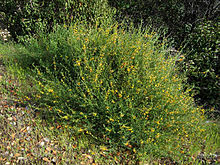- Lotus scoparius
-
Lotus scoparius 
Scientific classification Kingdom: Plantae (unranked): Angiosperms (unranked): Eudicots (unranked): Rosids Order: Fabales Family: Fabaceae Subfamily: Faboideae Tribe: Loteae Genus: Lotus Species: L. scoparius Binomial name Lotus scoparius
(Nutt.) OtleyLotus scoparius (Common Deerweed, Deer Weed, Deervetch, California Broom or Western Bird's-Foot Trefoil) is a perennial subshrub in the family Fabaceae (pea family).[1] The plant is a pioneer species found in dry areas of California, Arizona, and Mexico. It is commonly found in many areas including chaparral, coastal sand and roadsides at elevations below 1500 m.
Contents
Description
The Lotus scoparius stems are green, erect, somewhat branched, with small, deciduous, pinnate leaves consisting of three to six leaflets. The plant blooms from about March to August and has flowers that are bilateral, small (7-11 mm), yellow, and clustered together in an inflorescence consisting of 2 – 7 flowers in the upper leaf axils. The flowers become reddish with age. The fruit consists of a curved pod with two seeds.
Ecology
L. scoparius is a food consumed by numerous wildlife, providing intake for hummingbirds, bees, butterfly larvae, and deer.[2] Common plant associates in chaparral, especially in the transition between coastal chaparral and coastal sage scrub, include California sagebrush and Toyon.[3]
- Lotus scoparius var. scoparius is endemic to California.
See also
- Coastal sage scrub
- California coastal sage and chaparral ecoregion
Notes
References
- (2006) Theodore Payne Foundation: Lotus scoparius
- {2008} USDA webpage
- (2008) C. Michael Hogan: Toyon (Heteromeles arbutifolia), GlobalTwitcher, ed. N. Stromberg
External links
Categories:- Lotus (genus)
- Flora of California chaparral and woodlands
- Flora of Arizona
- Flora of Northwestern Mexico
- Butterfly food plants
- Honey plants
- Hummingbirds
Wikimedia Foundation. 2010.
